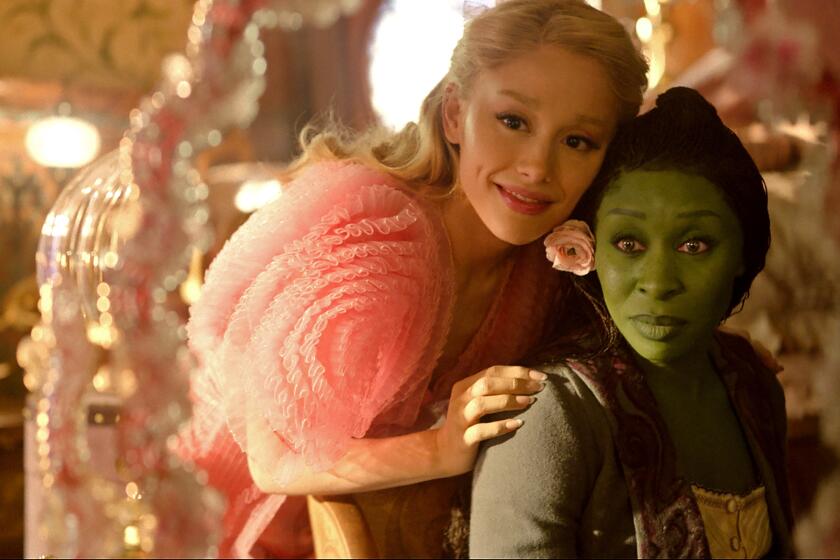Pair of Clowns Try ‘Jams’ to Fight Jeers, Rejection
ENCINO — A clown’s life isn’t always a barrel of laughs.
There are times when the kids don’t get the gag. Times when older, jaded teenagers jeer your act. Or demanding parents make you feel like an animal-balloon factory.
Philip Karp-Briggs and his wife, Heide, know the frustrations well. Both former clowns with Ringling Bros. & Barnum & Bailey Circus, they now make a living performing at children’s birthday parties, shopping centers, libraries and farmers markets.
“I’ve tried to not clown,” said Philip, 35. But “I’m a showoff. I love to do what I do to make people laugh. It’s kind of an addiction.”
To help himself and other clowns cope with rejection, insecurities and the need to share their experiences, Philip and Heide have started “clown jams.” The meetings are part practice session and part group therapy, where clowns learn that it’s OK sometimes not to be funny.
During a recent Tuesday night at the Encino Community Center dance room, six clowns and a self-described “clown sympathizer” pretended to be circus animal/human hybrids as part of a theatrical clowning exercise. They crawled on the wood floor, growled, licked their hands like felines and scratched their backs by rubbing up against the wall-to-wall mirrors.
At the jams, the clowns try to avoid what usually works. They push themselves hard, trying out routines that may not give an easy laugh.
Tisza Major, 26, of Hollywood, says her clowning career goal is to avoid becoming a hack in plastic red shoes.
“I don’t want to be the scary birthday clown,” said Major, an actor and balloon sculptor who performs weekends at Universal CityWalk. “We don’t need another ‘Homey the Clown,’ ” she added, referring to the cynical clown on “In Living Color.” “[Clowning] is a serious profession and an art form.”
Fear of Rejection Colors Reactions
Throughout their lives, Heide and Philip have embraced clowning, abandoned it and embraced it again. Though they have more than 30 years of clowning experience between them, they fear rejection whenever they perform.
The couple formed their own “Jumbo Shrimp Circus” seven years ago. They usually charge a hefty $500 per show, raising the audience’s expectations and the pressure. The pair hustle for gigs, driving about 40,000 miles a year in their minivan as they play at more than 100 events.
Most of their customers hear about them through from word of mouth, but the pair also sends postcard advertisements to elementary schools. They build their own props, travel with a sound system and spend about $3,000 a year on wardrobes. Recently the pair hired a publicist to drum up more theater shows.
If being clowns isn’t easy for Heide and Philip now, it wasn’t gentle at the beginning, either. Heide, 37, became a circus clown two decades ago. She spent about six years with mostly small circuses performing at county fairs.
Sometimes she had to shower with a garden hose, and often she slept in a sleeping bag.
Philip started clowning at parties a decade ago. At first, obnoxious kids enjoyed kicking him from behind; they stopped when he developed a more commanding persona. He and Heide still sometimes contend with teenagers jeering: “You’re not real clowns.”
The couple’s favorite audience is small kids with parents keeping a watchful eye on them, or seniors.
“Teens will poke fun and mentally harass us,” said Philip. “You have to be innocent to enjoy our show.
“It’s challenging for us to do what we do and be entertaining for jaded children,” he added. “It smacks of a simpler time, of vaudeville.”
Despite their success, the Karp-Briggses said they don’t want to be doing birthday parties when they’re 50. Both miss the days of a steady circus job. Heide hopes to work with the prestigious Cirque du Soleil. Philip sees himself one day becoming a mentor to future clowns, though he admits he’ll have to figure out a way to make money at it.
In the meantime, Philip and Heide are still doing their own gigs.
Need for Feedback Leads to Malaise
During a recent free Sunday-morning show at the Encino Farmers’ Market, Philip and Heide kept the crowd of parents and children chuckling as they juggled, rode unicycles and told jokes. Philip kicked his legs like a Rockette while on stilts; Heide made a grown man dress as a polar bear and wear a pink tutu.
After the 40-minute show, parents gathered around the pair to offer praise and ask for business cards.
But the two clowns weren’t as pleased as the audience. Heide complained the timing was off.
Philip, dressed in a yellow-and-orange body suit, his hair drenched with sweat, said such after-show malaise is common.
“Our insecurities demand we get the audience to respond verbally,” he said as he packed juggling clubs into a red road case. “If not, I start to feel terrible about my performance.
“Because I love it so much,” he said, “I’m sensitive to how people respond to me as a clown.”
More to Read
The biggest entertainment stories
Get our big stories about Hollywood, film, television, music, arts, culture and more right in your inbox as soon as they publish.
You may occasionally receive promotional content from the Los Angeles Times.










